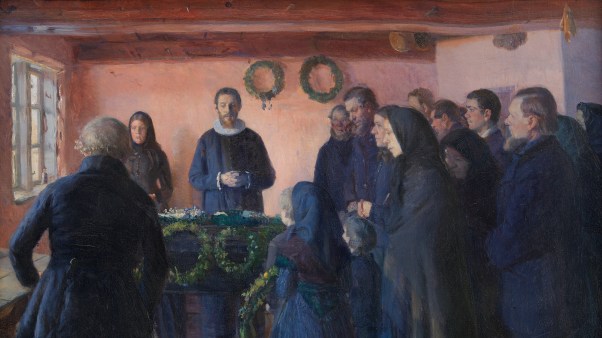“Nein!”
This was the title of an essay published 91 years ago by the Swiss Reformed theologian Karl Barth. It has a claim to being the most infamous and briefest theological rejoinder in church history. With his roar of No! Barth drew a line in the sand. He declared, with clarity and force, that theology not grounded in the Word of God must be viewed with grave suspicion—even presumed guilty.
In the decades since, Barth’s one-word rejection has been loathed, celebrated, imitated, and misunderstood. One lesson of his stern example is well summarized by another theologian, the late John Webster. Writing about biblical interpretation, Webster observed that “conflict … is not abnormal or necessarily destructive in the Christian community, but may prove a way in which Gods keeps the church in the truth.” Theological disagreement is not to be avoided at all costs. Sometimes we must state our differences plainly and entrust ourselves to the Spirit.
Michael Huerter’s new book, The Hybrid Congregation: A Practical Theology of Worship for an Online Era, is just such an opportunity for dispute. I admit I am inclined to follow Barth’s lead by limiting my response to a single word: Nein! Why? Because I believe the book’s proposals to be not only misguided but also hazardous. Their widespread acceptance and implementation would hamper and distort the mission and worship of the church. I hope, therefore, that the book’s recommendations will not find a hearing—that pastors will be inoculated against its arguments.
Stanley Hauerwas likes to pronounce blessing on heretics “because without them we would not know what we believe.” Huerter is no heretic; the problems with his book are not doctrinal but practical, liturgical, and technological. As a pastor and worship leader, he clearly loves God’s people and wants to enrich their praise of God in music and song.
I honor that desire by taking seriously what he has written. What I write in reply I offer in the spirit of fraternal critique. It is possible for Christians to disagree in public—even online—without rancor or malice. At least, I hope so.
The case for hybrid worship
The Hybrid Congregation is written for the world after COVID-19. It takes confusions prompted by the pandemic along with lessons learned from it and tries to synthesize these for churches navigating community and worship in a digital age.
“Church online is here to stay,” Huerter writes. He contends that the question is not whether church leaders should accept hybrid worship but how they can approach its challenges: “What does the church need to understand about digitally mediated interactions—their history, embodied impact, and effective use—in order for individual communities and ministers to make well-informed, effective, and contextually appropriate decisions in their ministry?”
Two worries underlie his answers to this question:
To the extent that we do not engage thoughtfully and intentionally with online and hybrid practices, we may miss opportunities for meaningful ministry or engage in practices that are ineffective or have negative impact. In a world that operates on networks of digitally mediated relationships that begin online and then find expression in physical space, a local church without an online presence appropriate to its surrounding community may find it impossible to connect with that community in a mutually positive relationship.
These sentences are so generic as to be misleading. The language is modest, the tone earnest, the suggestions seemingly anodyne. A church with an updated website and online ways for people to connect with ministries or contact pastors might fit the bill. Later, however, Huerter clarifies his position by writing that “digital engagement … is a part of our holistic discipleship. Removing digital realities from our faith is in fact an amputation of an important part of our cultural experience from our life together with each other and with God.”
In other words, non-hybrid church is a failure of ministry. It’s lopping off limbs from the body of Christ.
Huerter’s stated goal is to map “a middle way,” trading on the assumption that a “balance” between two purported extremes is always desirable. The heart of the book is a pair of chapters that consider four binaries pervading popular discussion of digital technology and Christian worship: active versus passive, embodied versus disembodied, mediated versus unmediated, and virtual versus real. Because our “lives are hybrid—online and offline—our ministry must reflect this,” Huerter says. And if recent digital “inventions are neither perfect nor depraved,” it follows that “we must seek spiritual discernment, not reactionary thinking.”
Huerter sets the stage for these core chapters with a potted history of media disruption and the rise of the internet, and he follows them with reflections on hybridity, church music, and “online ritual communities.” These communities are neither Christian nor religious—think viewers of video game livestreams or avid followers of the Harry Potter and the Sacred Text podcast. Huerter believes pastors responsible for public worship have much to learn from passionate online fandoms. At this point the pragmatic replaces the theological entirely. If it “works,” then it is self-recommending. (More on this below.)
Two bright spots in an otherwise muddled book are Huerter’s discussions of passivity and mediation. Defining passivity broadly to encompass acts of delegation, representation, and receptivity, Huerter is right that prioritizing activity over passivity in worship is neither theologically traditional nor philosophically sustainable.
Everything we do is a mix of active and passive, push and pull, give and take: We speak and listen, attack and defend, offer gifts and receive them. This is true of worship too. The pastor calls and the people respond. The leader prays and the people say amen. The priest consecrates and the people dine. This is the historic shape of Christian worship from the beginning. To indict online church with the simple charge of passivity is too easy. The charge doesn’t stick.
Likewise, Huerter is correct that mediation is not a drag on worship but is its nerve center. The gospel does not proclaim an unmediated relationship with God. It proclaims instead the “one mediator between God and men, the man Christ Jesus” (1 Tim 2:5, RSV). The Good News is not freedom from mediators but mediation that is faithful, reliable, and true.
As Christ’s own body and the temple of his Spirit, the church itself plays a mediating role in the economy of grace, above all in the liturgy of Word and sacrament. Until the day we glimpse the Lord face-to-face, we will see him—and hear him and taste him—in the worship and mysteries of the church, as “through a glass, darkly” (1 Cor 13:12, KJV).
In this life, then, desiring total spiritual immediacy is a blind alley, a dead end, even a temptation. Huerter is right to critique evangelical worship practices that carefully curate experiences while affecting spontaneity, and he’s right that mediation in Christ is good and God-ordained. But Huerter goes further, claiming that God’s presence is “mediated through the internet.” Is he right about that?
The case against hybrid worship
The first problem with The Hybrid Congregation is its method, which Huerter holds up as a model for ministers. About this I will not mince words: The way Huerter arrives at his conclusions is by turns naive, superficial, incurious, and uncritical.
The book is an exercise in “practical theology.” One of the hallmarks of this academic style is an emphasis on interdisciplinarity, subjective experience, spiritual practices, and the authority of credentialed experts. Because practical theologians want to analyze ordinary Christian life through a theological lens, they are fond of ethnography, which typically involves embedding oneself in a particular community, observing its rhythms, and offering a thick description of its inner culture.
A method common to sociology and anthropology, ethnography always risks mistaking an is for an ought. This is precisely where Huerter falters. Time and time again, he offers description passing as prescription—as though the mere fact that someone does X or thinks Y means that X or Y must be good or inevitable and thus accepted, permitted, or encouraged. The book assumes what it never demonstrates.
For instance, Huerter writes that “it is no longer possible … to draw a firm dividing line between online and offline.” Who says? Or “digital media do not carry more inherent potential for evil, or less for good, than a church building, a pew, or a book.” Really? Show me the evidence. Or recall quotes I excerpted above, such that online church “is here to stay” or that digital devices are not “depraved.” I certainly think they’re depraved, and none of us knows the future of online church.
Claims this big require more than assertion. This is the next problem: The Hybrid Congregation is not an exploration but a conclusion in search of an argument. We cannot know whether digital inventions are depraved or whether a balance between extremes is desirable until we’ve conducted a genuine inquiry, and the inquiry is not genuine if we decide in advance that the answer cannot possibly be no. For Huerter, ruling out the value of digital church was never an option.
When he does reach for evidence, Huerter relies on interviews with “experts” as a kind of final word on the questions he’s addressing. The experts in question—eight in total—are scholars, pastors, and researchers who, to a person, are utterly sold on “digital religion” and online expressions of worship. Huerter does not subject any claims from these interviewees to even a semblance of critical examination. The assertions simply lie on the page, uncontested, the oracles of experts who know better, putting Luddites and know-nothings to shame.
Consider DJ Soto, who “is a member of the governing board of Metaverse Church and serves as bishop of Virtual Reality Church and MMO Church” (the initialism stands for “massively multiplayer online”). Here are some of Soto’s thoughts, all of which appear verbatim in the book, though not in this continuous fashion:
In five to ten years, the future of the church will be the metaverse.
Whether it’s a Sunday morning, one-hour event, [or] a Bible study, it’s all going to be based out of your centralized metaverse.
For people who are homebound, this metaverse thing is the answer. It is the solution for them.
It’s the first time in history where we’re having these face-to-face interactions, avatar to avatar, in these immersive worlds.
We haven’t done this, but we’re going to very soon, let’s say there’s a worship song about heaven and then the ground beneath you turns into clouds. Light starts forming all around you.
The younger generation gets it, the younger thinkers get it. They were birthed in Minecraft servers and Fortnite interactions and V-bucks. … The next gen of church planters are going to go crazy once they get into it, because they’re not hesitant. They’re not reluctant. There [are] no theological qualms for them.
In the last line, we are meant to understand the lack of theological caution as a virtue. Huerter does not challenge this view—and he might have been able to get away with it had he written this book one or two decades ago. As it is, the great incongruity of The Hybrid Congregation is its timing: The culture’s once-sunny optimism about the social internet is well past its sell-by date. To say it has curdled would be an understatement.
Here is another problem. Digital devices haven’t become “invisible,” something we never think of or worry about, as Huerter describes them. On the contrary, tech is a subject of constant consternation. States are passing laws getting phones out of schools. Moms are appealing to Congress to protect children from Silicon Valley. Prestigious secular scholars are writing bestsellers about digital dangers. And yet Huerter’s book includes a single tech-skeptical citation, a brief reference to a New York Times column by Tish Harrison Warren presented as a foil and summarily dismissed.
The result of this method and its ill-timed question begging is a straw man so thin it collapses at a touch. Huerter dismisses those who disagree with him as uninformed. Their “bias” needs to be “better informed” through “intentional reflection” and “discernment” to arrive at “nuance.” I’ll pass. Some of us are plenty well-read on the subject, and everything we’ve learned has only strengthened our tech skepticism, not softened it.
Technologists love to write in the future tense, as the quotes from DJ Soto exemplify. They have visited the future and returned to tell us what is to come. Instead of trembling before visions of a digitized future, however, we should remember the promise of Moses: “When a prophet speaks in the name of the Lord, if the word does not come to pass or come true, that is a word which the Lord has not spoken; the prophet has spoken it presumptuously, you need not be afraid of him” (Deut. 18:22, RSV).
Sacraments, embodiment, and reality
One oddity of the book is Huerter’s consistently equivocal use of terms like worship, ministry, and church. What he often means by these words is music—which makes sense since he is himself a musician and worship leader. At times Huerter turns his attention specifically to music, but elsewhere it’s clear he has music in mind even when his language would suggest he’s referring to the whole of Christian life, community, and worship. This also makes sense if, in one’s liturgical imagination, music is the essence or main event of public worship.
As I read, though, something nagged at me about this, and I finally realized what it was: the sacraments. In a book about Christian worship, the Lord’s Supper and baptism barely appear. This is an astonishing omission in a book full of them.
The historic pattern of the church’s liturgy finds its summit in the Eucharist. Granted, not every church follows this pattern today, but no believer would deny the importance of the Supper to Christian worship. The Lord instituted it mere hours before his death. All Christians recognize that Word and sacrament go hand in hand. And though it is possible to hear the Word online, no one can receive Communion or be baptized through a screen.
To put it plainly, we need our bodies to feast at the Lord’s Table. And at a minimum, baptism requires water and two human bodies. When Jesus said, “Where two or three are gathered in my name, there am I among them” (Matt 18:20, ESV), he did not mean online.
Sacraments are physical rituals, and their stubborn materiality points to other basic human actions that cannot be digitally mediated. The Supper is a literal meal, as we’ve seen. And Scripture teaches that baptism unites you to Christ with an intimacy so profound that the only human analogy is the one-flesh union of husband and wife (1 Cor. 6:15–20; Eph. 5:25–33). In a word, just as baptism and the Eucharist are impossible over the internet, so are eating and sex. These are also conspicuous in their absence from The Hybrid Congregation, and with good reason: They undermine the very notion of “online church,” “digital being,” and “metaverse worship.”
Matters get even worse when Huerter speaks of “face-to-face encounters” in virtual reality. He’s not talking about a video call. He’s talking about digital avatars, animations and emojis with vaguely human characteristics. His rationale is that the “face of the other” cannot be reduced to “a physical experience.” Perhaps not, but the human face has here been euphemized into mere metaphor. Lost is the actual face of another person.
Huerter insists this strikes us as amiss only because we continue to pit embodiment against disembodiment, the former being “real” and the latter “virtual.” He’s technically correct that interacting with digital surfaces, even signing on to the metaverse, remains embodied inasmuch as living human beings are embodied in all that we do. But this is a strange argument to make; it justifies far too little or far too much. Injecting my veins with heroin is embodied, but that doesn’t make it good for me. So is living 24 hours a day in a pleasure pod that manipulates my brain into experiencing continuous conscious pleasure. Here, then, is another straw man.
Consider the steel man instead: The screens of our digital devices are, by design, instruments of distraction, sedation, and enfeeblement. They are bright, colorful, and eye-catching, but ultimately they numb and exhaust human vitality. They draw us away from human faces, etched by the hand of God, the better to mesmerize us with superficial pleasures and mindless beguilements. The more we use them, the less we are able to pray. The more they capture our attention, the less we glory in the splendor of God’s creation. The more they deaden our senses, the less alive we are to the gift of existence and the wonders of reality.
And yes, I said reality. This is a precious word, and Christians would be wise to protect it. In his 1992 novel Snow Crash, where he coined the word metaverse, Neal Stephenson never fails to distinguish between the digital world and the real world. He even gives the latter a capital R: “the real world—planet Earth, Reality.” It turns out this binary isn’t a bad one. It’s crucial to human dignity and to living well as creatures, even in a digital age.
We Christians may live hybrid lives, but Huerter is wrong to want worship to be hybrid. Keep it analog, keep it bodily, keep it physical and difficult and full of friction. Say no to metaverse church. Say yes to the body of Christ.
Brad East is an associate professor of theology at Abilene Christian University. He is the author of four books, including The Church: A Guide to the People of God and Letters to a Future Saint.






















